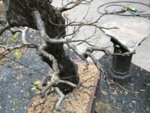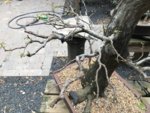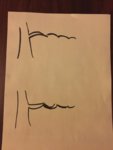That whole Walter Pall hedge trimming method is crap
Until you read all the way down to this part.
"From the beginning of October to the next March, the crown can be cut again. During its dormancy the tree will not be encouraged to bud out again. When the leaves are off, one can finally see what was produced over the summer. The entire crown has become much denser, and there is much that needs work. Many branch stumps are created that must be removed now. The same with dead branches or parts of branches. But there are so many shoots that one can chose with which to work - the others can be removed completely. Sometimes you even have the problem of having too many branches to chose from. Most of the little branches will be cut back to one bud (opposite budding trees like maples) or two buds (alternate budding trees like hornbeams). In some areas where the crown needs developing less is removed. As a result of this work the tree will look quite beautiful. At this point, you can also recognize which branches should be changed in their position. They can the be wired the traditional way, or moved with the help of guy wires."
@jasonpg the absolute truth is....
Both Boon and Walter create good trees and are dedicated to their craft.
You have started with WP * method...
So switching to an entirely different schools method NOW, may not be the best way forward.
For no reason other than switching strategies mid stride is not usually efficient in any endeavor. *
You have some time to research this.
From simple observation, it seems Walter does 2 mindless cuts and one detailed one.
The only difference I see...
Walter's method leaves us needing to make larger cuts to clean up what knuckles we created.
This is why the above paragraph can not be omitted from the method.
Walter's ENTIRE * method also heals those cuts enough to continue building beautiful branching. Which may be why switching now could be detrimental. *
Not to smash....both make good trees...
But a couple more TRUTHS....
A search for Boon Maples to post at the same quality as Walters, to prove both methods work, was unsuccessful for me, though I know they exist.
+1 WP
I have never seen anyone come here inspired by a Boon tree, either in the form of using it as an avatar pic, or using the picture in a first post. People use WP trees all the time.
+1 WP
I love that Boon teaches, and teaches students to teach, clearly he has minions!
Paying Minions.
Walter doesn't use minions, or sell DVD's, people like me love his trees and his ability to teach us a simpler method and freely share the information.
Outreach is the Same, Global, WP more recognizable.
+1 WP
You have never heard....
(Provided you read all the way thru Walter's ENTIRE ENTIRE method before dismissing it as crap)
Walter saying...
Scott, I agree, tridents are too much work!
But Boon Students agree....
Walter's Method is easier!
#fulltruthonlyplease
Resorce
Sorce








